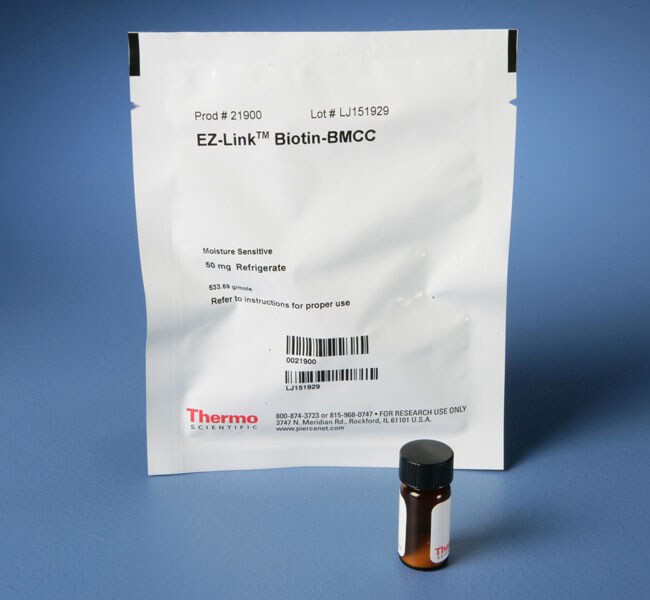Search Thermo Fisher Scientific

Certificates | 증명서
SDS
인용 및 참조 문헌 (1)
Thermo Scientific™
EZ-Link™ BMCC-Biotin
Thermo Scientific EZ-Link BMCC-Biotin is a maleimide-activated, sulfhydryl-reactive biotinylation reagent with an extended spacer arm that contains a stabilizing cyclohexane자세히 알아보기
| 카탈로그 번호 | 수량 |
|---|---|
| 21900 | 50 mg |
카탈로그 번호 21900
제품 가격(KRW)
380,000
Online offer
Ends: 30-Sep-2025
447,000할인액 67,000 (15%)
Each
재고 준비 예상일 보류
수량:
50 mg
제품 가격(KRW)
380,000
Online offer
Ends: 30-Sep-2025
447,000할인액 67,000 (15%)
Each
Thermo Scientific EZ-Link BMCC-Biotin is a maleimide-activated, sulfhydryl-reactive biotinylation reagent with an extended spacer arm that contains a stabilizing cyclohexane group.
Features of EZ-Link BMCC-Biotin:
• Protein labeling—biotinylate antibodies or other proteins for use in protein methods
• Membrane-permeable—can be used to label inside cells (intracellular)
• Thiol-reactive—reacts with sulfhydryls (-SH), such as the side-chain of cysteine (C)
• Maleimide-activated—perform reactions at pH 6.5 to 7.5 in buffers such as PBS
• Irreversible—forms permanent thioether bonds; spacer arm cannot be cleaved
• Solubility—must be dissolved in DMSO or DMF before further dilution in aqueous buffers
• Medium length—spacer arm (total length added to target) is 32.6 angstroms; contains cyclohexane ring, which stabilizes adjacent maleimide
BMCC-Biotin is a maleimido-biotin compound for labeling protein cysteines and other molecules that contain sulfhydryl groups. This reagent specifically reacts with reduced thiols (-SH) in near-neutral buffers to form permanent (irreversible) thioether bonds. The unique feature of BMCC-Biotin is its spacer arm cyclohexane ring; this has a stabilizing effect that minimizes hydrolysis and degradation of the maleimide group until it has opportunity to conjugate with target thiols.
We manufacture biotin reagents to ensure the highest possible overall product integrity, consistency and performance for the intended research applications.
Biotinylation reagents differ in reactivity, length, solubility, cell permeability and cleavability. Three types of sulfhydryl-reactive compounds are available: maleimido, iodoacetyl and pyridyldithiol. Maleimide reagents specifically react with sulfhydryl groups (-SH) in near-neutral buffers to form permanent thioether bonds.
In proteins, sulfhydryls exist where there are cysteine (C) residues. Cystine disulfide bonds must be reduced to make sulfhydryl groups available for labeling. Hinge-region disulfide bridges of antibodies can be selectively reduced to make functional half-antibodies that can be labeled.
Features of EZ-Link BMCC-Biotin:
• Protein labeling—biotinylate antibodies or other proteins for use in protein methods
• Membrane-permeable—can be used to label inside cells (intracellular)
• Thiol-reactive—reacts with sulfhydryls (-SH), such as the side-chain of cysteine (C)
• Maleimide-activated—perform reactions at pH 6.5 to 7.5 in buffers such as PBS
• Irreversible—forms permanent thioether bonds; spacer arm cannot be cleaved
• Solubility—must be dissolved in DMSO or DMF before further dilution in aqueous buffers
• Medium length—spacer arm (total length added to target) is 32.6 angstroms; contains cyclohexane ring, which stabilizes adjacent maleimide
BMCC-Biotin is a maleimido-biotin compound for labeling protein cysteines and other molecules that contain sulfhydryl groups. This reagent specifically reacts with reduced thiols (-SH) in near-neutral buffers to form permanent (irreversible) thioether bonds. The unique feature of BMCC-Biotin is its spacer arm cyclohexane ring; this has a stabilizing effect that minimizes hydrolysis and degradation of the maleimide group until it has opportunity to conjugate with target thiols.
We manufacture biotin reagents to ensure the highest possible overall product integrity, consistency and performance for the intended research applications.
Biotinylation reagents differ in reactivity, length, solubility, cell permeability and cleavability. Three types of sulfhydryl-reactive compounds are available: maleimido, iodoacetyl and pyridyldithiol. Maleimide reagents specifically react with sulfhydryl groups (-SH) in near-neutral buffers to form permanent thioether bonds.
In proteins, sulfhydryls exist where there are cysteine (C) residues. Cystine disulfide bonds must be reduced to make sulfhydryl groups available for labeling. Hinge-region disulfide bridges of antibodies can be selectively reduced to make functional half-antibodies that can be labeled.
For Research Use Only. Not for use in diagnostic procedures.
사양
세포 투과성Cell-Permeant
라벨 유형Biotin & Analogs
제품라인EZ-Link™
제품 유형BMCC-Biotin
수량50 mg
반응성 부분Maleimide
화학물질 반응성Thiol
라벨 또는 염료Biotin
용해도DMF (Dimethylformamide), DMSO (Dimethylsulfoxide)
스페이서Extra-long
Unit SizeEach
구성 및 보관
Store at 4°C.
Have questions about this product? Ask our AI assisted search.
This is an AI-powered search and may not always get things right. You can help us make it better with a thumbs up or down on individual answers or by selecting the “Give feedback" button. Your search history and customer login information may be retained by Thermo Fisher and processed in accordance with our
Privacy Notice.
자주 묻는 질문(FAQ)
그림

Chemical structure of BMCC-Biotin

Properties of BMCC-Biotin
Customers who viewed this item also viewed
문서 및 다운로드
Certificates | 증명서
Lot 번호 또는 부분 Lot 번호로 검색하십시오.
Lot 번호Certificate TypeDateCatalog Number(s)
AB401348Certificate of Analysis2025년 2월 18일21900
ZK398753Certificate of Analysis2024년 12월 16일21900
ZG394659Certificate of Analysis2024년 8월 20일21900
ZF391225Certificate of Analysis2024년 6월 25일21900
ZD391224Certificate of Analysis2024년 4월 26일21900
시험 성적서 관련 5 개의 결과가 검색되었습니다.
Safety Data Sheets | 물질 안전 보건 자료
SDS
Product Information
Molecular Probes® 핸드북
인용 및 참조 문헌 (1)
Search citations by name, author, journal title or abstract text
인용 및 참조 문헌
Abstract
Rif1 S-acylation mediates DNA double-strand break repair at the inner nuclear membrane.
Journal:Nat Commun
PubMed ID:31182712
'Rif1 is involved in telomere homeostasis, DNA replication timing, and DNA double-strand break (DSB) repair pathway choice from yeast to human. The molecular mechanisms that enable Rif1 to fulfill its diverse roles remain to be determined. Here, we demonstrate that Rif1 is S-acylated within its conserved N-terminal domain at cysteine
1 total citations